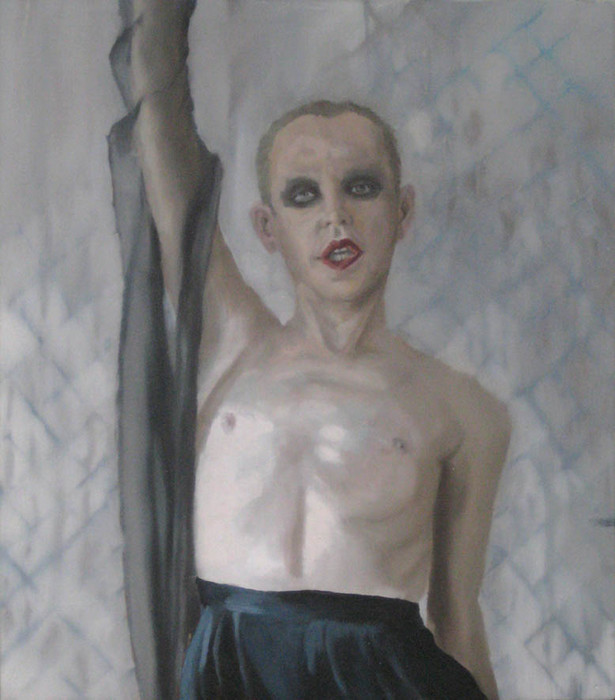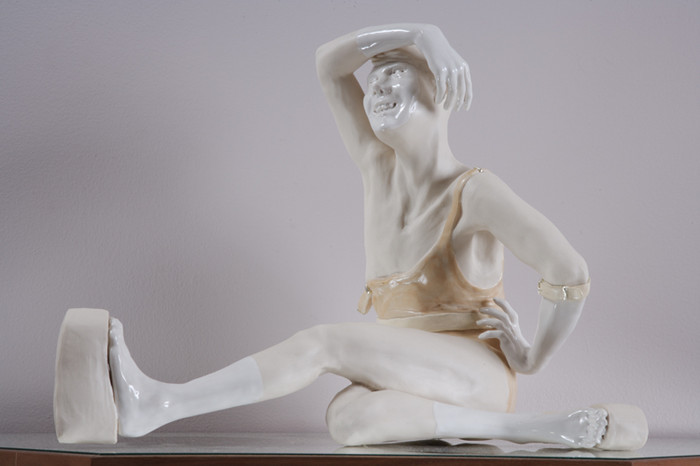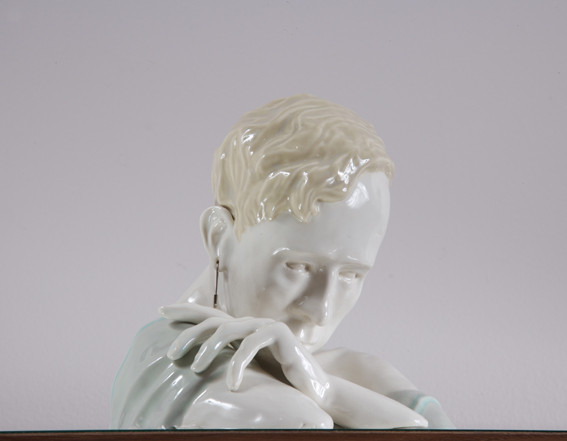Jared Buckhiester. Glory Can't Help Herself
16 Oct - 17 Nov 2009
The childhood of Jared Buckhiester (*1977) in a southern Baptist community in Dahlonega, Georgia can be considered as significant for his work. Even if he studied at the BFA Pratt Institute and being based in New York since 1995, his topics and motifs are basically related to his southern American past. As long as human beings are not involved, his drawings and pictures function like the grim and nostalgic views of Andrew Wyeth or Edward Hopper. Lonely houses in rural or suburban surroundings, literally described fragments of nature or whole sceneries, bulls, cattle, cows and chickens suggest a pastoral idyll or the atmosphere of small towns, but as soon as people enter the scene, these settings are foiled and used as a personal stage by whimsical figures.
In his carefully executed drawings Buckhiester depicts the pronounced revolt of adolescent figures against the social conventions of their small hometowns and definitely American environment. Drifting into seemingly better worlds of fantasy like in Vogue to Death (2004) or It’s about Queers in love with their bullies (2007) their masquerading, the diabolic and their gothic-style become the immediate expression of their longing for individuality. Contrary to possible speculations this behaviour does not express a primary revolt against religious principles, but rather introspective processes, self-discovery and emotional status. The lascivious poses and sights as well as the metrosexual or even homosexual impression some figures convey, reveal sexual identity and physicalness as subliminal and continuous issues in the work of Buckhiester.
Already in his early drawings like Seniors Rule at Sucking Cock (2004), which have the effect of snap-shots, Buckhiester presents himself as a sensitive and humorous observer, even if the conveyance of humour is not his intention. He rather unmasks the lethargy in the behaviour and actions of the allegedly progressive protagonists, which almost like caricatures, seem to become a parody of themselves. These unhappy attempts of social breakout establish the aesthetics of suffering in the works of Jared Buckhiester, which implies the claim for self- and social acceptance.
This impression is strengthened by the technical approach. His emphasized figurative picture language and the meticulous handling of detail in his pencil drawings, watercolours and recently in his oil paintings as well as his restrained choice of colours, produce the same fragile and delicate effect that characterizes his ceramic sculptures. As these sculptures are explicitly titled according to the name of the sitter and therefore portraits like Tim Radcliff (2007), the autobiographic feature in the work of Jared Buckhiester becomes obvious. Especially in his portrait busts Buckhiester plays with illusionistic effects, which invite the viewer to complete the figure. By means of cranky poses, idiosyncratic body decoration as well as a mimic and gazes, that are hard to grasp, Buckhiester develops a strangely lost charisma, which is underlined by the partial coloration and the varying glossy and matt effects. Buckhiester’s sculptural work reflects in this sense his drawn figures and can explicitly be understood, as it’s plastic extension.
His traditional execution, the frail effect it causes and the rural southern states idyll form a bizarre and for Jared Buckhiester typical contrast to the attitude and habitus of his figures. In connection with the fictive elements in his pictures, which recall fantasy novels or the uncanny “in-between worlds” of filmmakers like David Lynch, his works slide into a nightmare-fantasy genre, located between reality and illusion.
(Uta Ruhkamp, 2009)
In his carefully executed drawings Buckhiester depicts the pronounced revolt of adolescent figures against the social conventions of their small hometowns and definitely American environment. Drifting into seemingly better worlds of fantasy like in Vogue to Death (2004) or It’s about Queers in love with their bullies (2007) their masquerading, the diabolic and their gothic-style become the immediate expression of their longing for individuality. Contrary to possible speculations this behaviour does not express a primary revolt against religious principles, but rather introspective processes, self-discovery and emotional status. The lascivious poses and sights as well as the metrosexual or even homosexual impression some figures convey, reveal sexual identity and physicalness as subliminal and continuous issues in the work of Buckhiester.
Already in his early drawings like Seniors Rule at Sucking Cock (2004), which have the effect of snap-shots, Buckhiester presents himself as a sensitive and humorous observer, even if the conveyance of humour is not his intention. He rather unmasks the lethargy in the behaviour and actions of the allegedly progressive protagonists, which almost like caricatures, seem to become a parody of themselves. These unhappy attempts of social breakout establish the aesthetics of suffering in the works of Jared Buckhiester, which implies the claim for self- and social acceptance.
This impression is strengthened by the technical approach. His emphasized figurative picture language and the meticulous handling of detail in his pencil drawings, watercolours and recently in his oil paintings as well as his restrained choice of colours, produce the same fragile and delicate effect that characterizes his ceramic sculptures. As these sculptures are explicitly titled according to the name of the sitter and therefore portraits like Tim Radcliff (2007), the autobiographic feature in the work of Jared Buckhiester becomes obvious. Especially in his portrait busts Buckhiester plays with illusionistic effects, which invite the viewer to complete the figure. By means of cranky poses, idiosyncratic body decoration as well as a mimic and gazes, that are hard to grasp, Buckhiester develops a strangely lost charisma, which is underlined by the partial coloration and the varying glossy and matt effects. Buckhiester’s sculptural work reflects in this sense his drawn figures and can explicitly be understood, as it’s plastic extension.
His traditional execution, the frail effect it causes and the rural southern states idyll form a bizarre and for Jared Buckhiester typical contrast to the attitude and habitus of his figures. In connection with the fictive elements in his pictures, which recall fantasy novels or the uncanny “in-between worlds” of filmmakers like David Lynch, his works slide into a nightmare-fantasy genre, located between reality and illusion.
(Uta Ruhkamp, 2009)



